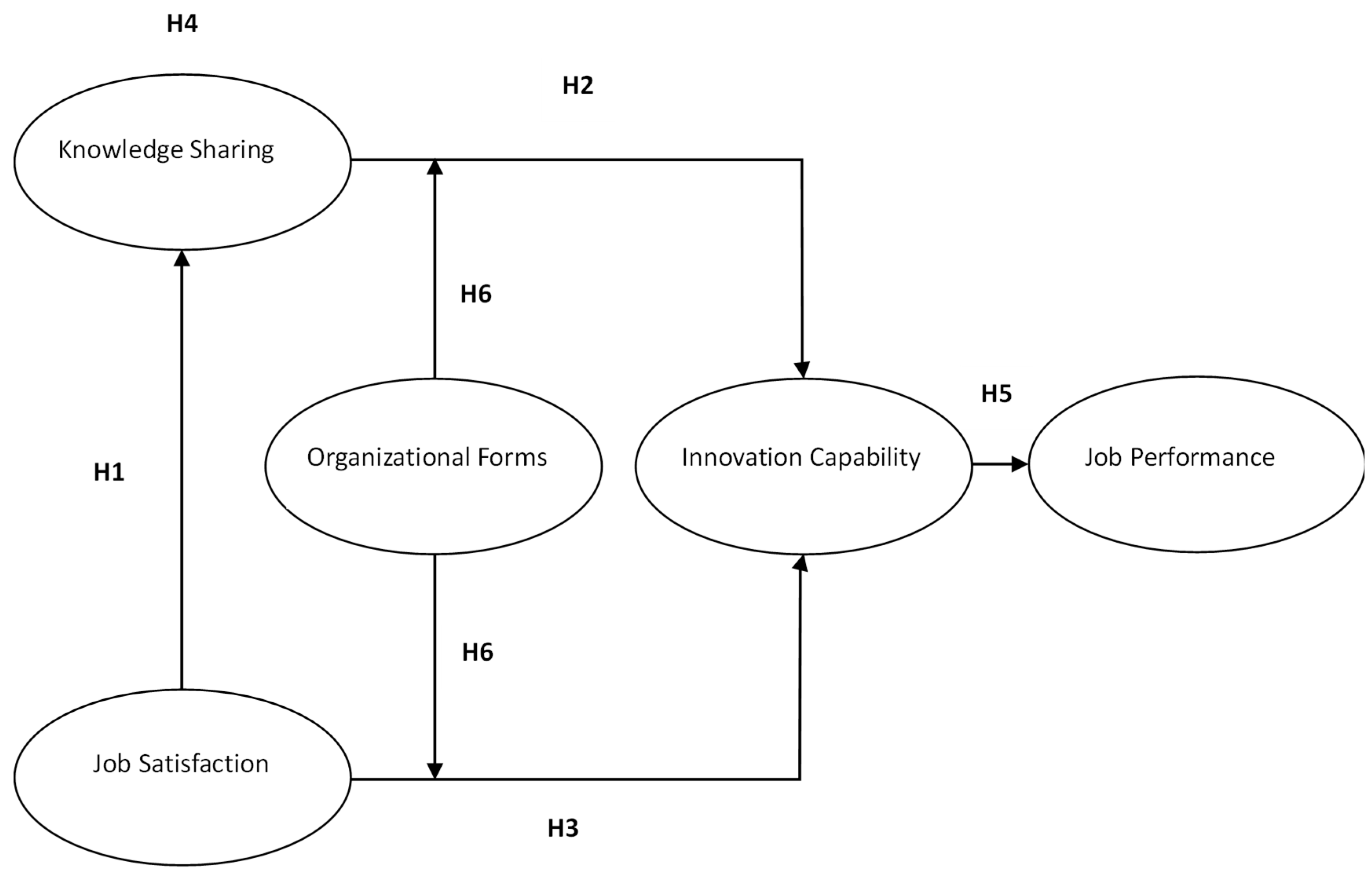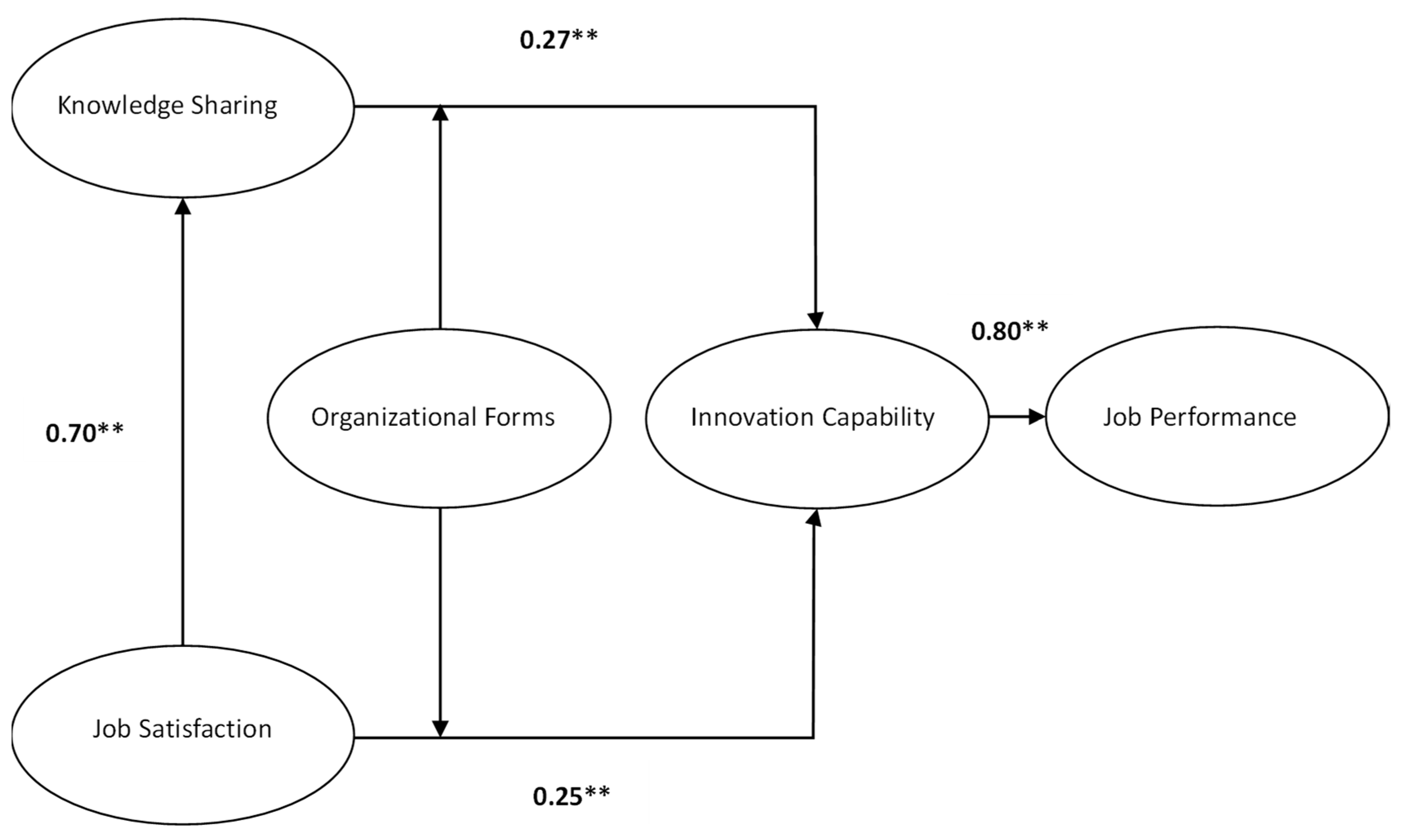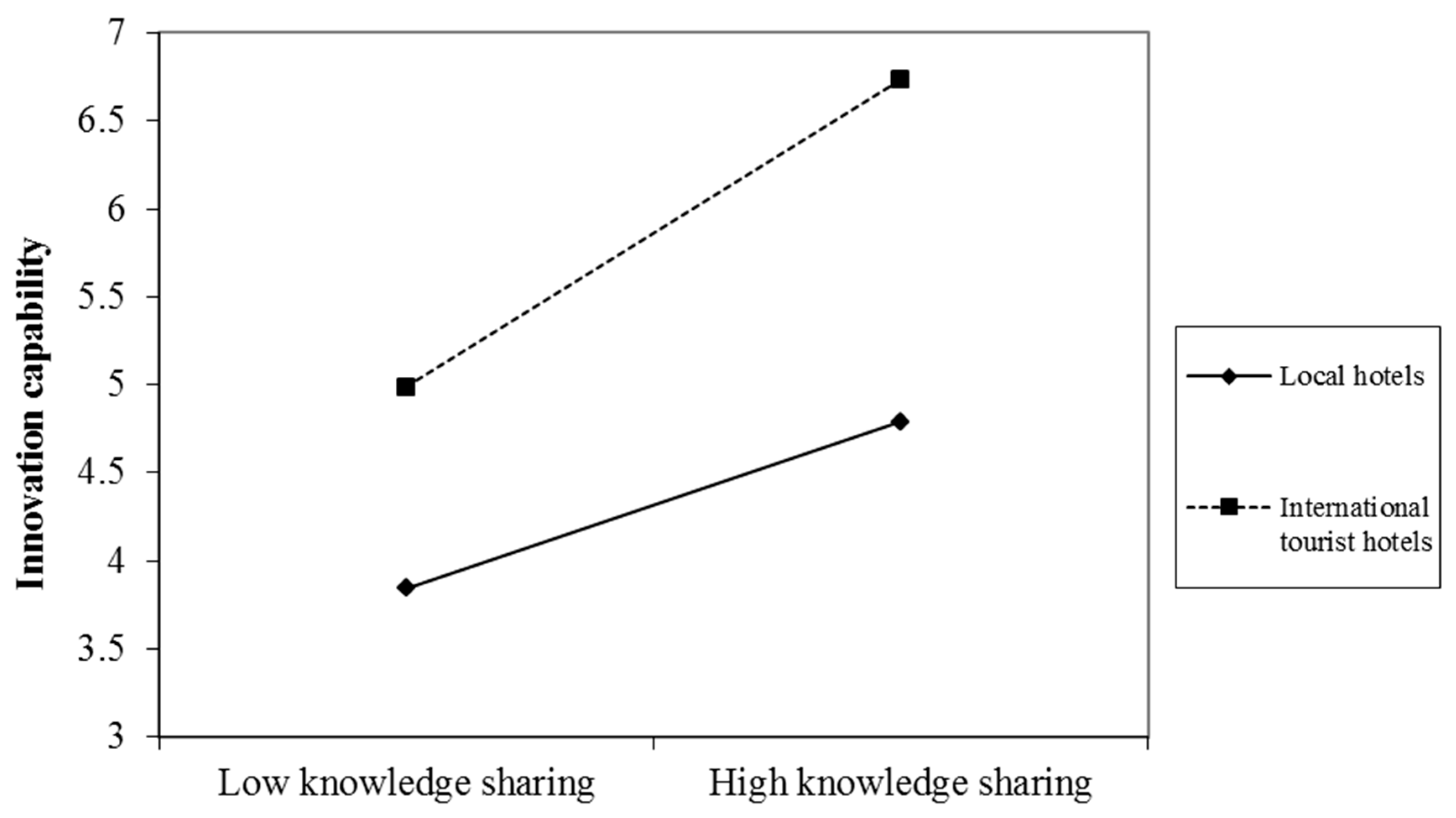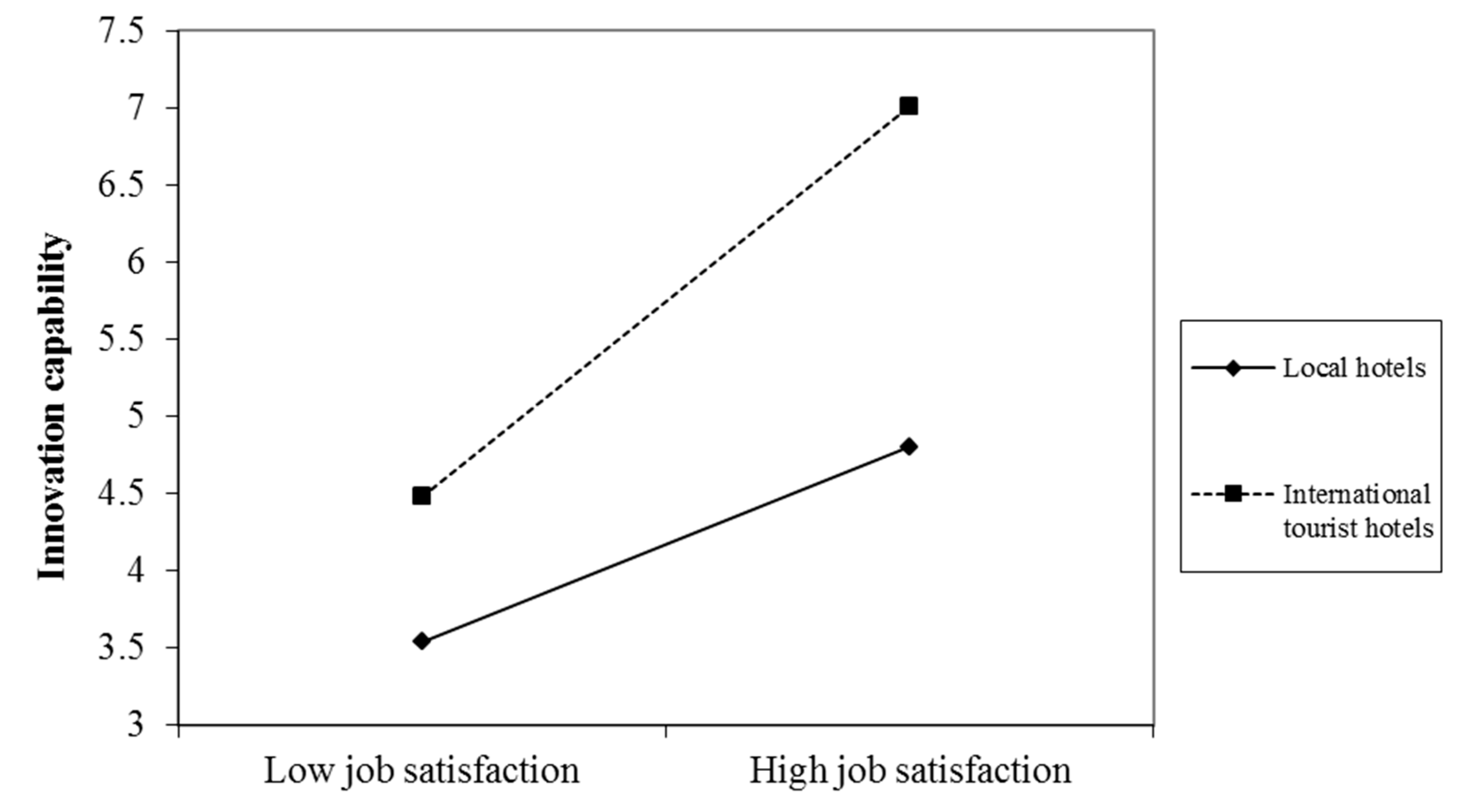Linking Sustainable Human Resource Management in Hospitality: An Empirical Investigation of the Integrated Mediated Moderation Model
Abstract
1. Introduction
2. Literature Review
2.1. Job Satisfaction
2.2. Knowledge Sharing
2.3. Innovation Capability
2.4. Job Performance
3. Conceptual Framework and Hypotheses Development
3.1. Relationship between Job Satisfaction and Knowledge Sharing
3.2. Relationship between Knowledge Sharing and Innovation Capability
3.3. Relationship between Job Satisfaction and Innovation Capability
3.4. Mediating Effects of Knowledge Sharing Orientation
3.5. Relationship between Innovation Capability and Job Performance
3.6. Moderating Effects of Organizational Forms
4. Methodology
4.1. The Research Model
4.2. Data Collection and Sampling Frame
4.3. Construct Measurement
4.4. Data Analysis
5. Results
5.1. Confirmatory Factor Analyses
5.2. Hypotheses Testing
6. Discussion
7. Conclusions
Funding
Acknowledgments
Conflicts of Interest
References
- Kramar, R. Beyond strategic human resource management: Is sustainable human resource management the next approach? Int. J. Hum. Resour. Manag. 2014, 25, 1069–1089. [Google Scholar] [CrossRef]
- Stankevičiūtė, Ž.; Savanevičienė, A. Designing Sustainable HRM: The Core Characteristics of Emerging Field. Sustainability 2018, 10, 4798. [Google Scholar] [CrossRef]
- Jabbour, C.J.C.; Santos, F.C.A. The central role of human resource management in the search for sustainable organizations. Int. J. Hum. Resour. Manag. 2008, 19, 2133–2154. [Google Scholar] [CrossRef]
- Stankevičiūtė, Ž.; Savanevičienė, A. Raising the Curtain in People Management by Exploring How Sustainable HRM Translates to Practice: The Case of Lithuanian Organizations. Sustainability 2018, 10, 4356. [Google Scholar] [CrossRef]
- App, S.; Buttgen, M. Lasting footprints of the employer brand: Can sustainable HRM lead to brand commitment? Empl. Relat. 2016, 38, 703–723. [Google Scholar] [CrossRef]
- Drucker, P.F.; Collins, J.C.; Kotler, P.; Kouzes, J.M.; Rodin, J.; Rangan, V.K.; Hesselbein, F. The Five Most Important Questions You Will Ever Ask about Your Organization; Leader to Leader Institute: New York, NY, USA, 2008. [Google Scholar]
- Andersson, M.; Karlsson, C. Knowledge in Regional Economic Growth—The Role of Knowledge Accessibility. Ind. Innov. 2007, 14, 129–149. [Google Scholar] [CrossRef]
- Benn, S.; Teo, S.T.T.; Martin, A. Employee participation and engagement in working for the environment. Pers. Rev. 2015, 44, 492–510. [Google Scholar] [CrossRef]
- Brown, M.; Hyatt, D.; Benson, J. Consequences of the performance appraisal experience. Pers. Rev. 2010, 39, 375–396. [Google Scholar] [CrossRef]
- Baum, T.; Cheung, C.; Kong, H.; Kralj, A.; Mooney, S.; Nguyễn Thị Thanh, H.; Ramachandran, S.; Dropulić Ružić, M.; Siow, M.L. Sustainability and the Tourism and Hospitality Workforce: A Thematic Analysis. Sustainability 2016, 8, 809. [Google Scholar] [CrossRef]
- Damanpour, F.; Daniel Wischnevsky, J. Research on innovation in organizations: Distinguishing innovation-generating from innovation-adopting organizations. J. Eng. Technol. Manag. 2006, 23, 269–291. [Google Scholar] [CrossRef]
- Daft, R.L.; Lewin, A.Y. Where Are the Theories for the “New” Organizational Forms? An Editorial Essay. Organ. Sci. 1993, 4, i–vi. [Google Scholar]
- Kazlauskaite, R.; Buciuniene, I. The Role of Human Resources and Their Management in the Establishment of Sustainable Competitive Advantage. Inz. Ekon. 2008, 78–84. [Google Scholar]
- Dumont, J.; Shen, J.; Deng, X. Effects of Green HRM Practices on Employee Workplace Green Behavior: The Role of Psychological Green Climate and Employee Green Values. Hum. Resour. Manage. 2017, 56, 613–627. [Google Scholar] [CrossRef]
- Cleveland, J.N.; Byrne, Z.S.; Cavanagh, T.M. The future of HR is RH: Respect for humanity at work. Hum. Resour. Manag. Rev. 2015, 25, 146–161. [Google Scholar] [CrossRef]
- Gelhard, C.; von Delft, S. The role of organizational capabilities in achieving superior sustainability performance. J. Bus. Res. 2016, 69, 4632–4642. [Google Scholar] [CrossRef]
- Donnelly, R. Aligning knowledge sharing interventions with the promotion of firm success: The need for SHRM to balance tensions and challenges. J. Bus. Res. 2019, 94, 344–352. [Google Scholar] [CrossRef]
- Evans, W.R.; Davis, W.D. High-performance work systems and organizational performance: The mediating role of internal social structure. J. Manag. 2005, 31, 758–775. [Google Scholar] [CrossRef]
- HakemZadeh, F.; Baba, V.V. Toward a theory of collaboration for evidence-based management. Manag. Decis. 2016, 54, 2587–2616. [Google Scholar] [CrossRef]
- Jackson, S.E.; Schuler, R.S.; Jiang, K.F. An Aspirational Framework for Strategic Human Resource Management. Acad. Manag. Ann. 2014, 8, 1–56. [Google Scholar] [CrossRef]
- Lee, K.H. Why and how to adopt green management into business organizations? The case study of Korean SMEs in manufacturing industry. Manag. Decis. 2009, 47, 1101–1121. [Google Scholar] [CrossRef]
- Fritz, C.; Lam, C.F.; Spreitzer, G.M. It’s the Little Things That Matter: An Examination of Knowledge Workers’ Energy Management. Acad. Manag. Perspect. 2011, 25, 28–39. [Google Scholar] [CrossRef]
- Horng, J.S.; Wang, C.J.; Liu, C.H.; Chou, S.F.; Tsai, C.Y. The Role of Sustainable Service Innovation in Crafting the Vision of the Hospitality Industry. Sustainability 2016, 8, 223. [Google Scholar] [CrossRef]
- Locke, E. The Nature and Causes of Job Satisfaction. Handb. Ind. Organ. Psychol. 1976, 31, 1297–1349. [Google Scholar]
- Hulin, C.L.; Judge, T.A. Job attitudes: A theoretical and empirical review. In Handbook of Psychology; Borman, W.C., Ilgen, D.R., Klimoski, R.J., Eds.; Wiley Press: Hoboken, NJ, USA, 2003; pp. 255–276. [Google Scholar] [CrossRef]
- Reiner, M.D.; Zhao, J. The Determinants of Job Satisfaction Among United States Air Force Security Police: A Test of Rival Theoretical Predictive Models. Rev. Public Pers. Adm. 1999, 19, 5–18. [Google Scholar] [CrossRef]
- Judge, T.A.; Locke, E.A.; Durham, C.C.; Kluger, A.N. Dispositional effects on job and life satisfaction: The role of core evaluations. J. Appl. Psychol. 1998, 83, 17–34. [Google Scholar] [CrossRef] [PubMed]
- Judge, T.A.; Erez, A.; Bono, J.E. The power of being positive: The relation between positive self-concept and job performance. Hum. Perform. 1998, 11, 167–187. [Google Scholar] [CrossRef]
- Herzberg, F. One More Time: How do You Motivate Employees? Harv. Bus. Rev. 2003, 81, 87–96. [Google Scholar]
- Porter, H.; Wrench, J.S.; Hoskinson, C. The Influence of Supervisor Temperament on Subordinate Job Satisfaction and Perceptions of Supervisor Sociocommunicative Orientation and Approachability. Commun. Q. 2007, 55, 129–153. [Google Scholar] [CrossRef]
- Zhang, Q.; Sun, S.; Zheng, X.; Liu, W. The Role of Cynicism and Personal Traits in the Organizational Political Climate and Sustainable Creativity. Sustainability 2019, 11, 257. [Google Scholar] [CrossRef]
- Nonaka, I. The Knowledge-Creating Company. Harv. Bus. Rev. 1991, 69, 96–104. [Google Scholar]
- Miller, D.; Shamsie, J. The Resource-Based View of the Firm in Two Environments: The Hollywood Film Studios From 1936 to 1965. Acad. Manage. J. 1996, 39, 519–543. [Google Scholar] [CrossRef][Green Version]
- Alavi, M.; Leidner, D.E. Knowledge management systems: Issues, challenges, and benefits. Commun. Ais 1999, 1, 1. [Google Scholar] [CrossRef]
- Teece, D.J. Strategies for Managing Knowledge Assets: The Role of Firm Structure and Industrial Context. Long Range Plan. 2000, 33, 35–54. [Google Scholar] [CrossRef]
- Van den Hooff, B.; de Ridder, J.A. Knowledge sharing in context: The influence of organizational commitment, communication climate and CMC use on knowledge sharing. J. Knowl. Manag. 2004, 8, 117–130. [Google Scholar] [CrossRef]
- Davenport, T.; Prusak, L. Working Knowledge: How Organizations Manage What They Know; Harvard Business Press: Boston, MA, USA, 1998. [Google Scholar]
- Fagerberg, J.; Sapprasert, K. National Innovation Systems: The Emergence of a New Approach. Sci. Public Policy 2011, 38, 669–679. [Google Scholar] [CrossRef]
- Croitoru, A.; Schumpeter, J.A. The Theory of Economic Development: An Inquiry into Profits, Capital, Credit, Interest and the Business Cycle, New Brunswick (U.S.A) and London (U.K.). J. Comp. Res. Anthropol. Sociol. 2012, 3, 137–148. [Google Scholar]
- Thompson, P.; Wallace, T. Redesigning production through teamworking: Case studies from the Volvo Truck Corporation. Int. J. Oper. Prod. Manage. 1996, 16, 103–118. [Google Scholar] [CrossRef]
- Amabile, T.M.; Conti, R.; Coon, H.; Lazenby, J.; Herron, M. Assessing the work environment for creativity. Acad. Manage. J. 1996, 39, 1154–1184. [Google Scholar]
- Van de Ven, A.H. Central Problem in the Management of Innovation. Manag. Sci. 1986, 32, 590–607. [Google Scholar] [CrossRef]
- Tidd, J.; Pavitt, K. Managing Innovation: Integrating Technological, Market And Organizational Change; John Wiley and Sons Ltd.: Hoboken, NJ, USA, 2005. [Google Scholar]
- Leonard, J.W. Imitation to Innovation: The Dynamics of Korea’s Technological Learning. Acad. Manag. Perspect. 1997, 11, 102–103. [Google Scholar] [CrossRef]
- Burgelman, R.A.; Christensen, C.M.; Wheelwright, S.C. Strategic Management of Technology and Innovation; McGraw-Hill/Irwin: New York, NY, USA, 2008. [Google Scholar]
- Lawson, B.; Samson, D. Developing innovation capability in organisations: A dynamic capabilities approach. Int. J. Innov. Manag. 2001, 5, 377–400. [Google Scholar] [CrossRef]
- Wang, C.-J.; Tsai, C.-Y. Managing innovation and creativity in organizations: An empirical study of service industries in Taiwan. Serv. Bus. 2014, 8, 313–335. [Google Scholar] [CrossRef]
- Banks, C.; Murphy, K. Toward narrowing the research-practice gap in performance appraisal. Pers. Psychol. 1985, 38, 335–345. [Google Scholar] [CrossRef]
- Napier, N.K.; Latham, G.P. Outcome expectancies of people who conduct performance appraisals. Pers. Psychol. 1986, 39, 827–837. [Google Scholar] [CrossRef]
- Bretz, R.D.; Milkovich, G.T.; Read, W. The Current State of Performance Appraisal Research and Practice: Concerns, Directions, and Implications. J. Manag. 1992, 18, 321–352. [Google Scholar] [CrossRef]
- McCrae, R.R.; Costa, P.T. Validation of the five-factor model of personality across instruments and observers. J. Pers. Soc. Psychol. 1987, 52, 81–90. [Google Scholar] [CrossRef] [PubMed]
- Campbell, J.P. Modeling the performance prediction problem in industrial and organizational psychology. In Handbook of industrial and organizational psychology. In Handbook of Industrial and Organizational Psychology, 2nd ed.; Consulting Psychologists Press: Palo Alto, CA, USA, 1990; Volume 1, pp. 687–732. [Google Scholar]
- Hidding, G.J.; Catterall, S.M. Anatomy of a learning organization: Turning knowledge into capital at Andersen Consulting. Knowl. Process Manag. 1998, 5, 3–13. [Google Scholar] [CrossRef]
- Bussing, A.; Bissels, T.; Fuchs, V.; Perrar, K.-M. A Dynamic Model of Work Satisfaction: Qualitative Approaches. Hum. Relat. 1999, 52, 999–1028. [Google Scholar] [CrossRef]
- Han, T.-S.; Chiang, H.-H.; Chang, A. Employee participation in decision making, psychological ownership and knowledge sharing: Mediating role of organizational commitment in Taiwanese high-tech organizations. Int. J. Hum. Resour. Manag. 2010, 21, 2218–2233. [Google Scholar] [CrossRef]
- Koys, D.J. The effects of employee satisfaction, organizational citizenship behavior, and turnover on organizational effectiveness: A unit-level, longitudinal study. Pers. Psychol. 2001, 54, 101–114. [Google Scholar] [CrossRef]
- Hendriks, P. Why share knowledge? The influence of ICT on the motivation for knowledge sharing. Knowl. Process Manag. 1999, 6, 91–100. [Google Scholar] [CrossRef]
- Bock, G.-W.; Kim, Y.-G. Breaking the Myths of Rewards: An Exploratory Study of Attitudes about Knowledge Sharing. Inf. Resour. Manag. J. 2002, 15, 14–21. [Google Scholar] [CrossRef]
- Nonaka, I. A Dynamic Theory of Organizational Knowledge Creation. Org. Sci. 1994, 5, 14–37. [Google Scholar] [CrossRef]
- Lampel, J.; Mintzberg, H.; Brian Quinn, J.; Ghoshal, S. The Strategy Process: Concept, Context, Cases; Pearson Education: London, UK, 2003. [Google Scholar]
- Mumford, M.D. Managing creative people: Strategies and tactics for innovation. Hum. Resour. Manag. Rev. 2000, 10, 313–351. [Google Scholar] [CrossRef]
- Damanpour, F.; Schneider, M. Phases of the Adoption of Innovation in Organizations: Effects of Environment, Organization and Top Managers1. Brit. J. Manage. 2006, 17, 215–236. [Google Scholar] [CrossRef]
- Herzberg, F.; Mausner, B.; Snyderman, B. The Motivation to Work, 2nd ed.; John Wiley: Oxford, UK, 1959; Volume XV, p. 157. [Google Scholar]
- McGrath, R.G. Exploratory Learning, Innovative Capacity and Managerial Oversight. Acad. Manag. J. 2001, 44, 118–131. [Google Scholar] [CrossRef]
- Delmas, M. Innovating against European rigidities: Institutional environment and dynamic capabilities. J. High Technol. Manag. Res. 2002, 13, 19–43. [Google Scholar] [CrossRef]
- Helfat, C.E.; Raubitschek, R.S. Product sequencing: Co-evolution of knowledge, capabilities and products. Strateg. Manag. J. 2000, 21, 961–979. [Google Scholar] [CrossRef]
- Barney, J. Firm Resources and Sustained Competitive Advantage. J. Manag. 1991, 17, 99–120. [Google Scholar] [CrossRef]
- Aoki, M. Information, Incentives and Bargaining in the Japanese Economy; Cambridge University Press: Cambridge UK, 1990. [Google Scholar]
- Ichniowski, C.; Shaw, K.; Prennushi, G. The Effects of Human Resource Management Practices on Productivity: A Study of Steel Finishing Lines. Am. Econ. Rev. 1997, 87, 291. [Google Scholar]
- Hansen, M.T. The Search-Transfer Problem: The Role of Weak Ties in Sharing Knowledge across Organization Subunits. Adm. Sci. Q. 1999, 44, 82–111. [Google Scholar] [CrossRef]
- Fiol, C.; Lyles, M. Organizational Learning. Acad. Manag. Rev. 1985, 10, 803–813. [Google Scholar] [CrossRef]
- Nair, A.; Trendowski, J.; Judge, B. A Review of Edith Penrose’s, ‘Theory of the Growth of the Firm’. Acad. Manag. Rev. 2008, 33, 1026–1028. [Google Scholar] [CrossRef]
- Walstad, W.B. The Effect of Economic Knowledge on Public Opinion of Economic Issues. J. Econ. Educ. 1997, 28, 195–205. [Google Scholar] [CrossRef]
- Weiss, D.J.; Dawis, R.V.; England, G.W. Manual for the Minnesota Satisfaction Questionnaire. Minn. Stud. Vocat. Rehabil. 1967, 22, 120. [Google Scholar]
- Scott, S.G.; Bruce, R.A. Determinants of innovative behavior—A path model of individual innovation in the workplace. Acad. Manage. J. 1994, 37, 580–607. [Google Scholar]
- Lee, T.W.; Locke, E.A.; Latham, G.P. Goal setting theory and job performance. In Goal Concepts in Personality and Social Psychology; Lawrence Erlbaum Associates, Inc.: Hillsdale, NJ, USA, 1989; pp. 291–326. [Google Scholar]
- Anderson, J.C.; Gerbing, D.W. Structural equation modeling in practice—A review and recommended two step approach. Psychol. Bull. 1988, 103, 411–423. [Google Scholar] [CrossRef]
- Bollen, K.A. Structural Equations with Latent Variables; John Wiley & Sons: Oxford, UK, 1989; Volume XIV, p. 514. [Google Scholar]
- Jöreskog, K.G.; Sörbom, D. Recent developments in structural equation modeling. J. Mark. Res. 1982, 19, 404–416. [Google Scholar] [CrossRef]
- Baron, R.M.; Kenny, D.A. The moderator mediator variable distinction in social psychological-research—Conceptual, strategic, and statistical considerations. J. Pers. Soc. Psychol. 1986, 51, 1173–1182. [Google Scholar] [CrossRef]
- Bardoel, E.A.; Pettit, T.M.; De Cieri, H.; McMillan, L. Employee resilience: An emerging challenge for HRM. Asia Pac. J. Hum. Resour. 2014, 52, 279–297. [Google Scholar] [CrossRef]
- Luthans, F.; Avey, J.B.; Avolio, B.J.; Peterson, S.J. The Development and Resulting Performance Impact of Positive Psychological Capital. Hum. Resour. Dev. Q. 2010, 21, 41–67. [Google Scholar] [CrossRef]
- Chang, H.-H.; Chien, G.C.L. Input-Process-Output of Hotel Training in Taiwan. Asia Pac. J. Tour. Res. 2012, 17, 246–260. [Google Scholar] [CrossRef]




| Mean | S.D. | 1 | 2 | 3 | 4 | 5 | 6 | 7 | 8 | 9 | 10 | 11 | |
|---|---|---|---|---|---|---|---|---|---|---|---|---|---|
| 1. Age | 2.44 | 0.83 | - | ||||||||||
| 2. Capital | 3.50 | 1.65 | 0.02 | - | |||||||||
| 3. Education | 2.23 | 0.56 | −0.08 | 0.31 ** | - | ||||||||
| 4. Industry | 2.01 | 1.02 | 0.15 ** | −0.40 ** | −0.23 ** | - | |||||||
| 5. People | 2.32 | 1.65 | 0.09 | 0.62 ** | 0.27 ** | −0.24 ** | - | ||||||
| 6. Sex | 1.44 | 0.49 | −0.18 ** | −0.18 ** | −0.25 ** | 0.14 ** | −0.18 ** | - | |||||
| 7. Tenure | 1.66 | 1.05 | 0.54 ** | −0.01 | −0.18 ** | 0.15 ** | 0.05 | −0.03 | - | ||||
| 8. Job Satisfaction | 5.49 | 0.87 | 0.11 * | −0.04 | −0.03 | 0.18 ** | −0.05 | 0.02 | 0.04 | 0.81 | |||
| 9. Knowledge Sharing | 5.62 | 0.75 | 0.07 | 0.06 | 0.09 | 0.08 | 0.00 | −0.09 | −0.01 | 0.59 ** | 0.74 | ||
| 10. Innovation Capability | 3.71 | 0.58 | −0.04 | 0.02 | 0.14 ** | −0.10 | −0.12 * | 0.03 | −0.06 | 0.18 ** | 0.26 ** | 0.74 | |
| 11. Job Performance | 4.24 | 0.57 | 0.00 | −0.02 | 0.10 * | −0.08 | −0.06 | 0.05 | −0.07 | 0.10 * | 0.09 | 0.67 ** | 0.71 |
| Fit Indices | Model Value | Reference Value | Overall Model Fit |
|---|---|---|---|
| χ2/df | 2.39 | <5.00 | Yes |
| CFI | 0.93 | >0.90 | Yes |
| GFI | 0.90 | >0.90 | Yes |
| IFI | 0.93 | >0.90 | Yes |
| NFI | 0.90 | >0.90 | Yes |
| SRMR | 0.05 | <0.05 | Yes |
| Models | χ2 | df | △χ2 | △df | GFI | CFI | NFI | IFI | RMSEA | SRMR |
|---|---|---|---|---|---|---|---|---|---|---|
| 1-Factor model | 1954 | 275 | 0.64 | 0.69 | 0.66 | 0.70 | 0.12 | 0.13 | ||
| 2-Factor model a | 1461 | 274 | 493 | 1.00 | 0.73 | 0.78 | 0.75 | 0.78 | 0.10 | 0.11 |
| 3-Factor model b | 789 | 272 | 1165 | 3.00 | 0.85 | 0.91 | 0.86 | 0.91 | 0.07 | 0.05 |
| 4-Factor model (proposed model) | 644 | 269 | 1310 | 6.00 | 0.90 | 0.93 | 0.90 | 0.93 | 0.05 | 0.05 |
| Regression Weights | Path Coefficients | Bootstrapping | |||||
|---|---|---|---|---|---|---|---|
| Percentile 95% Confidence Interval | Bias-corrected Percentile 95% Confidence Interval | Two Tailed Significance | |||||
| Standard Error | Lower | Upper | Lower | Upper | |||
| Standardized Direct Relations | |||||||
| Job Satisfaction → Knowledge Sharing | 0.70 | 0.11 | 0.07 | 0.46 | 0.07 | 0.45 | 0.00** |
| Knowledge Sharing → Innovation Capability | 0.27 | 0.09 | 0.05 | 0.34 | 0.05 | 0.35 | 0.00** |
| Job Satisfaction → Innovation Capability | 0.25 | 0.09 | 0.05 | 0.28 | 0.05 | 0.28 | 0.00** |
| Innovation Capability → Job Performance | 0.80 | 0.11 | 0.08 | 0.57 | 0.08 | 0.58 | 0.00** |
| Standardized Indirect Relations | |||||||
| Job Satisfaction → Innovation Capability | 0.19 | 0.04 | 0.01 | 0.13 | 0.01 | 0.13 | 0.00** |
| Knowledge Sharing → Job Performance | 0.22 | 0.03 | 0.02 | 0.14 | 0.02 | 0.14 | 0.00** |
| Job Satisfaction → Job Performance | 0.15 | 0.04 | 0.02 | 0.14 | 0.02 | 0.15 | 0.00** |
| χ2 | df | △χ2 | △df | P Value | |
|---|---|---|---|---|---|
| Non-Constrained Model | 993.19 | 542 | |||
| Constrained Model | 999.63 | 544 | 6.44 | 2.00 | 0.046 * |
| Hypothesis | Path | Result |
|---|---|---|
| H1 | Job satisfaction → Knowledge sharing | Accepted |
| H2 | Knowledge sharing → Innovation capability | Accepted |
| H3 | Job satisfaction → Innovation capability | Accepted |
| H4 | Job satisfaction → Knowledge sharing → Innovation capability | Accepted |
| H5 | Innovation capability → Job performance | Accepted |
| H6 | Moderating effects of organizational forms | Accepted |
© 2019 by the author. Licensee MDPI, Basel, Switzerland. This article is an open access article distributed under the terms and conditions of the Creative Commons Attribution (CC BY) license (http://creativecommons.org/licenses/by/4.0/).
Share and Cite
Wang, C.-J. Linking Sustainable Human Resource Management in Hospitality: An Empirical Investigation of the Integrated Mediated Moderation Model. Sustainability 2019, 11, 1066. https://doi.org/10.3390/su11041066
Wang C-J. Linking Sustainable Human Resource Management in Hospitality: An Empirical Investigation of the Integrated Mediated Moderation Model. Sustainability. 2019; 11(4):1066. https://doi.org/10.3390/su11041066
Chicago/Turabian StyleWang, Chung-Jen. 2019. "Linking Sustainable Human Resource Management in Hospitality: An Empirical Investigation of the Integrated Mediated Moderation Model" Sustainability 11, no. 4: 1066. https://doi.org/10.3390/su11041066
APA StyleWang, C.-J. (2019). Linking Sustainable Human Resource Management in Hospitality: An Empirical Investigation of the Integrated Mediated Moderation Model. Sustainability, 11(4), 1066. https://doi.org/10.3390/su11041066





